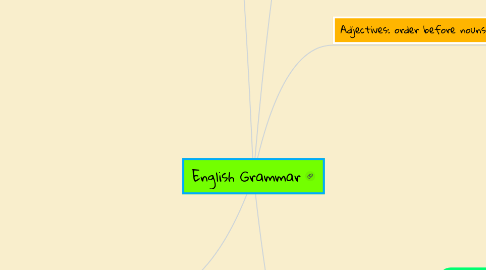
1. The definite article
1.1. USE "THE"
1.1.1. To talk about something in specific.
1.1.1.1. They're delivering the oil tomorrow.
1.2. DO NOT USE "THE"
1.2.1. To talk about something in general.
1.2.1.1. Oil has nearly doubled in price recently.
1.3. RULES
1.3.1. "You know which one(s)"
1.3.1.1. Please close the door.
1.3.2. Generalizations + sing. countable nouns
1.3.2.1. The tiger is in danger of dying out.
1.3.3. Groups or classes of people
1.3.3.1. The rich are not always happy.
1.3.4. Uniqueness
1.3.4.1. The earth goes around the sun.
1.3.5. Points of the compass
1.3.5.1. The north/ the south/ the west/ the east
1.3.6. Time expressions
1.3.6.1. The past
1.3.7. Place names
1.3.7.1. The United States.
1.4. OMISSIONS OF "THE"
1.4.1. Generalizations + plural uncountable nouns
1.4.1.1. Books are expensive.
1.4.2. Some places name
1.4.2.1. Oxford street
1.4.3. Games and sports
1.4.3.1. We love playing tennis.
1.4.4. Subjects of study
1.4.4.1. I'm afraid I most drop literature.
1.4.5. Languages
1.4.5.1. Can you speak French?
1.4.6. Meals and clock times
1.4.6.1. What time do you have dinner? At nine o'clock.
1.4.7. Musical instruments
1.4.7.1. I used to play the piano.
1.4.8. Some special cases
1.4.8.1. at/from home
1.4.8.2. on earth
1.4.8.3. by car
1.4.8.4. at Christmas
2. The indefinite article
2.1. A
2.1.1. It is used before a consonant.
2.2. AN
2.2.1. It is used before a vowel.
2.3. One
2.3.1. USES
2.3.1.1. In contrast with another or other(s)
2.3.1.1.1. One girl wanted to go out; but the others wanted to stay at home.
2.3.1.2. In the expression "one day"
2.3.1.2.1. One day I'll take you to meet my family.
2.3.1.3. With hundred and thousand when we want to sound precise
2.3.1.3.1. How many are there? About a hundred? 'Exactly one hundred and three'.
2.3.1.4. In expressions like "only one" and "just one"
2.3.1.4.1. We've got plenty of eggs, but only one sausage.
2.3.2. What kind of thing somebody or something is
2.3.2.1. She's a farmer/ They're farmers.
2.4. MAIN USES OF A/AN
2.4.1. What job a person does
2.4.1.1. He worked as taxi-driver/ They worked as taxi-drivers.
2.4.2. What something is used as
2.4.2.1. Don't use the plate as an ashtray/ Don't use the plates as ashtrays.
2.4.3. They can mean "any example of something"
2.4.3.1. A spider has eight legs/ Spiders have eight legs.
2.4.4. Plural: No article or some
2.4.4.1. I'd like a cup of tea/ I'd like some chips.
2.4.5. They can mean " a particular one"
2.4.5.1. A man called while you were out.
2.4.6. Don't use them
2.4.6.1. With uncountable nouns
2.4.6.1.1. *a rain
2.4.6.2. With possessives
2.4.6.2.1. *a my friend
2.4.6.3. After "kind of" or "sort of"
2.4.6.3.1. *a kind of a tree
2.4.7. Use them
2.4.7.1. In exclamations with "what"
2.4.7.1.1. What a pity!
2.4.7.2. After "quite", "rather" and "such"
2.4.7.2.1. quite/rather/such a nice day.
3. A difference between two opposite things or ideas.
4. Adjectives: order before nouns
4.1. Follow an order
4.1.1. "COORMAPUR"
4.1.1.1. COLOUR
4.1.1.1.1. red
4.1.1.2. ORIGIN
4.1.1.2.1. Spanish
4.1.1.3. MATERIAL
4.1.1.3.1. leather
4.1.1.4. PURPOSE
4.1.1.4.1. riding
4.1.1.5. NOUN
4.1.1.5.1. boots
4.2. OTHER ADJECTIVES
4.2.1. SIZE
4.2.2. LENGHT
4.2.3. HEIGHT
4.3. OPINION BEFORE DESCRIPTION
4.3.1. a lovely, long, drink
5. Prepositions of place
5.1. IN
5.1.1. Inside large areas
5.1.1.1. She grew up in France.
5.1.2. Forming part of a line
5.1.2.1. There's a missprint in line 22.
5.1.3. 3d space
5.1.3.1. I saw her in the supermarket.
5.2. ON
5.2.1. A line
5.2.1.1. Stratford is on the river Avon.
5.2.2. By a like or sea
5.2.2.1. My brother is on the sea.
5.2.3. A surface
5.2.3.1. Hurry up- supper's on the table.
5.2.4. Attached to
5.2.4.1. There're many oranges on the tree.
5.3. AT
5.3.1. A point
5.3.1.1. Turn left at the next corner.
5.3.2. Stage on a journey
5.3.2.1. The train stops at Paris.
5.3.3. Buildings
5.3.3.1. Activity
5.3.3.1.1. Eat the steak House.
5.3.3.2. Proper names
5.3.3.2.1. She works at Foster's.
5.3.3.3. Where people study
5.3.3.3.1. She's a student at Oxford.
5.3.3.4. Activities
5.3.3.4.1. at a concert
6. red Spanish leather riding boots.
7. the round glass table.
8. Dichotomies
8.1. Whole vs. All
8.1.1. We use "whole" with singular countable nouns.
8.1.1.1. A whole concert.
8.1.2. We use "all" with uncountable and plural nouns.
8.1.2.1. All the music.
8.1.3. The whole of
8.1.3.1. Before places names.
8.1.3.1.1. The whole of Europe.
8.1.4. Time expressions
8.1.4.1. The whole time/ All the time.
8.1.4.2. My whole life/ All my life.
8.1.4.3. The whole day/ All day.
8.2. Pronouns
8.2.1. Subjects before verbs
8.2.1.1. I, YOU, HE, SHE, IT, WE, YOU, THEY.
8.2.1.1.1. I like Mary/ We can't go on like this.
8.2.2. Other cases
8.2.2.1. ME, YOU HIM, HER, IT, US, THEM.
8.2.2.1.1. Objects after verbs
8.2.2.1.2. After prepositions
8.2.2.1.3. After BE
8.2.3. Short answers
8.2.3.1. Informal (me, him, etc.)
8.2.3.1.1. 'Who's paying?' 'Her'.
8.2.3.2. More formal (I, he, etc. + a verb)
8.2.3.2.1. 'Who's paying?' 'She is'.
8.3. Like vs. As
8.3.1. Like is a preposition, used before a noun or pronoun.
8.3.1.1. He runs like the wind.
8.3.2. As is a conjuction, used before subject+verb or a prepositional expression.
8.3.2.1. On Friday, as on Monday, we meet at eight.
8.4. Between vs. Among
8.4.1. AMONG: a group, crowd or mass of things that are not seen separately.
8.4.1.1. His house is hidden among the trees.
8.4.2. BETWEEN: two or more clearly separate people or things. Things on two sides.
8.4.2.1. She was standing between Alice and Mary.

